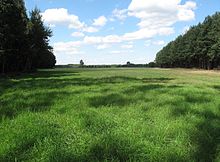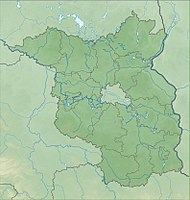Storkower Canal nature reserve
|
Storkower Canal nature reserve
|
||
|
The Storkower Canal in the protected area |
||
| location | Brandenburg , Germany | |
| surface | 96.19 km² | |
| Identifier | 1202 | |
| WDPA ID | 329658 | |
| Geographical location | 52 ° 16 ' N , 13 ° 52' E | |
|
|
||
| Setup date | June 16, 2004 | |
The Storkower Canal nature reserve is a 96.18 hectare nature reserve and FFH area in the Natura 2000 network in the Brandenburg districts of Oder-Spree and Dahme-Spreewald .
It is located in the Dahme-Heideseen nature park to the south and north of the eponymous Storkower Canal and the Stahnsdorfer River that flows into the canal . The purpose of protection is, in particular, the preservation of wild plant communities such as tall herbaceous meadows and crab claw meadows , broken forest communities and animal species in the moored lowland between the Stahnsdorfer and Wolziger lakes .
Location and natural space
The protected area lies on the boundaries of the two Storkow districts Alt Stahnsdorf and Kummersdorf and the district Wolzig of the municipality of Heidesee . It is located south of the Berlin glacial valley, through which the Spree flows, and west of the Storkower Platte in East Brandenburg's heath and lake area , which is listed as No. 82 in the main natural areas of Germany . The numerous lakes in the area are a relic of the Brandenburg stage (24,000 to 22,000) of the Vistula Ice Age . The area extends in a narrow strip from northeast to southwest almost along the entire Stahnsdorfer Fließ and along the western part of the Storkower Canal. Both water systems each have around half the area.

- The Stahnsdorfer Fließ forms the drain of the Stahnsdorfer See . The protected area begins just beyond the lake outlet of the little river at the county road K 6748 after sorrow village or at the present there historic watermill , in the list of monuments Storkower is registered. The area accompanies the river up to its confluence with the Storkower Canal north of Kummersdorf.
- The Storkower Canal enters the protected area from the southeast. This body of water also accompanies the protection zone in a narrow strip around 500 meters wide until shortly before it flows into Lake Wolziger . The canal is part of the 33.44-kilometer-long federal waterway Storkower Gewässer (SkG) , which drains the surrounding lakes and rivers from the Scharmützelsee over the Dahme to the Spree. The canal emerged from the Storkower Flößerkanal , which was laid out in 1732 and which was expanded into a canal during the reign of Frederick II in the middle of the 18th century. For centuries, in particular for supplying Berlin with timber used is its present traffic economic importance largely in the field of leisure - and tourism industry . As a rule, it is only used by passenger ships , pleasure boats and for water hikes .
The only other traffic artery is the single- track Königs Wusterhausen – Grunow railway line that crosses the protected area from south-east to north-west and bridges the Stahnsdorfer Fließ shortly after the Kummersdorf demand stop .
Conservation of nature, flora and fauna
Natura 2000 and FFH areas
The NSG Storkower Canal is part of the coherent European ecological network of special protection areas Natura 2000 . The profile of the Federal Agency for Nature Conservation (BfN) contains the following characterization for the 96.18 hectare FFH area under the number 3749-306:
"River silting complex with extensive accompanying alder, bog and quarry forests , tall herbaceous meadows , valuable small bodies of water with crab claw corridors and adjacent wet meadows ."
The ordinance on the nature reserve "Storkower Canal" of May 24, 2004 (the publication of the ordinance and thus its entry into force took place on June 15, 2004 in the Law and Ordinance Gazette for the State of Brandenburg ) provides under § 3 paragraph 5 as a protection purpose among other things Preservation and development of the area as an essential part of the interregional biotope network between the Dahmegewers and the Spreewald .
Plants and plant communities

Among the habitat types of FFH fact sheet lists the following plants or forest communities on humidity Hochstaudenfluren (Natura 2000 Code 6430), Lowland hay meadows (6510; Alopecurus pratensis , Sanguisorba officinalis ), alder-ash and Weichholzauenwälder (91E0; with Alnus glutinosa and Fraxinus excelsior (Alno-Padion, Alnion incanae, Salicion albae)) and running waters with flooding aquatic vegetation (3260; with Ranunculion fluitantis and Callitricho-Batrachion). The ordinance of the state emphasizes the protection of the well-developed riparian plant communities in particular of the Stahnsdorfer Fließ, including the various swamp forest communities populating the floodplain , the oak forests of the acidic soil locations, the extensively used wet meadow communities, the sedge beds and extensive reed beds .
The species in the area that are specially and strictly protected in accordance with Section 10 (2) No. 10 and 11 of the Federal Nature Conservation Act include: meadow horsetail ( Equisetum pratense ), field felt herb ( Filago arvense ) from the plant genus of felt herbs , crab claws ( Stratiotes aloides ) - Flower of the year in 1998, meadow knotweed ( Polygonum bistorta ), royal carnation ( Dianthus superbus ) and stiff-leaved orchid ( Dactylorhiza incarnata ). In addition, there are stocks of the flooding water crowfoot ( Ranunculus fluitans ), a species that is ecologically important as an oxygen producer and as a spawning plant . It is given as an ecological indicator value according to Ellenberg as an oceanic light plant for moderately warm to warm underwater locations. The crab claw also fulfills an important ecological function, as the dragonfly species, the green damsel, specializes in laying its eggs on the aquatic plant and is therefore tied to its occurrence.
Animals
According to Annex II of the Flora Fauna Habitat Directive and the country's regulation are particularly protected, including their for reproduction, nutrition, migration and wintering important habitats: among the mammals, the otter ( Lutra lutra ) and the fish of the asp ( Aspius aspius ) and the bitterling ( Rhodeus sericeus amarus ), the fish of the year 2008.
The otter, animal of the year 1999 in Germany, is threatened with extinction in Brandenburg . The marten, adapted to aquatic life, is one of the best swimmers among land carnivores and can stay under water for up to eight minutes. Fish represent a large part of its prey spectrum , whereby it prey predominantly small fish species and among them slow and weakened animals. It therefore has a role to play in keeping fish stocks healthy. The asp from the family of carp fish are found at an early age in small schools together, but develop in the adult age loners. A continuity of the waters is vital for this fish. The bitterling, which is also endangered according to the Red List in Brandenburg, finds the mussels necessary for its reproduction in the sandy bottom of the waters .
In addition, the state's ordinance lists the area as a habitat or retreat and a potential center of re-expansion for the following wild and specially and strictly protected animal species: crane ( Grus grus ), white stork ( Ciconia ciconia ), kingfisher ( Alcedo atthis ), lapwing ( Vanellus vanellus ) , Hobby ( Falco subbuteo ) Wendehals ( Jynx torquilla ), Sperbergrasmücke ( Sylvia nisoria ) Rotrückenwürger ( lanius collurio ) Schafstelze ( Motacilla flava flava ), silver stain notodontidae ( Spatalia Argentina ), reed bears ( Pelosia obtusa ), Meganola Albula ( Meganola albula ) [indicated in the regulation as: "Small bear ( Roselia albula )"], great river mussel ( Unio tumidus ) and grass snake ( Natrix natrix ). To the family of snakes belonging snake is completely harmless to humans and plays in legends and superstitions a positive role. Even today the grass snake is considered the patron saint of the inhabitants of the nearby Spreewald , whose cultural heritage includes the legend of the "Snake King". The gable tops of old Spreewald houses often show stylized crossed snake heads wearing a crown.
Maintenance measures
The ordinance in § 6 specifies the following objectives for maintenance and development measures:
- Quarry forest and reed areas on the banks of the waters should be left to their natural development and kept free from management ;
- Fresh and wet meadows should be used as far as possible through mowing and, if necessary, cleared ;
- the natural regeneration should take precedence over plantations are granted.
Web links
- Minister for Agriculture, Environmental Protection and Regional Planning of the State of Brandenburg: Ordinance on the "Storkower Canal" nature reserve of May 24, 2004 (GVBl.II / 04, No. 13, p. 338). Potsdam, May 24, 2004.
Individual evidence
- ↑ Brandenburg viewer, digital topographic maps 1: 10,000 (menu - "More data" - click and select accordingly; switch to the district boundaries "real estate cadastre" and there "districts".)
- ↑ Brigitte Nixdorf, Mike Hemm u. a .: Documentation of the condition and development of the most important lakes in Germany, part 5, Brandenburg , environmental research plan of the Federal Ministry for the Environment, Nature Conservation and Nuclear Safety , final report R&D project FKZ 299 24 274, on behalf of the Federal Environment Agency at the Chair of Water Protection at the Brandenburg Technical University Cottbus , 2004 Chapter 1.37 Wolziger See p. 155. PDF
- ↑ History of the Storkower Canal on the website of the Waterways and Shipping Office Berlin
- ↑ Cycling, hiking and waterway map Storkower Gewässer, Scharmützelsee . 1: 35,000. Verlag green heart , Dr. Lutz Gebhardt e. K., Ilmenau and Ostseebad Wustrow, 7th updated edition, July 2012 ISBN 978-3-86636-103-4 . The map shows the exact boundary of the protected area. See also the map attachment in the Protection Ordinance.
- ↑ a b c 3749-306 Storkower Canal. (FFH area) Profiles of the Natura 2000 areas. Published by the Federal Agency for Nature Conservation . Retrieved November 25, 2017.
- ↑ a b c d e Minister for Agriculture, Environmental Protection and Regional Planning of the State of Brandenburg: Ordinance on the "Storkower Canal" nature reserve of May 24, 2004. (GVBl.II / 04, No. 13, p. 338). Potsdam, May 24, 2004.
- ↑ Jürgen Klawitter, Rainer Altenkamp u. a .: Red list and total species list of mammals (Mammalia) from Berlin. (PDF; 203 kB) Processing status: December 2003. In: The State Commissioner for Nature Conservation and Landscape Management / Senate Department for Urban Development (ed.): Red lists of endangered plants and animals in Berlin . P. 6. Note: The Berlin list also contains the information for Brandenburg.
- ↑ Pisci Page Asp , Habitat and Biology (and click on "Distribution, Endangerment")
- ↑ Entire species list and red list of fish and lampreys (Pisces et Cyclostomata) from Berlin: p. 87 – p. 91 in Fish in Berlin - Balance of Species Diversity ", published by the Fisheries Office Berlin
- ↑ Grass snake at Spreewald Marketing, accessed on January 19, 2011.
- ↑ Snake King in the Spreewald, accessed on January 19, 2011. ( Memento of the original from September 3, 2013 in the Internet Archive ) Info: The archive link has been inserted automatically and has not yet been checked. Please check the original and archive link according to the instructions and then remove this notice.




